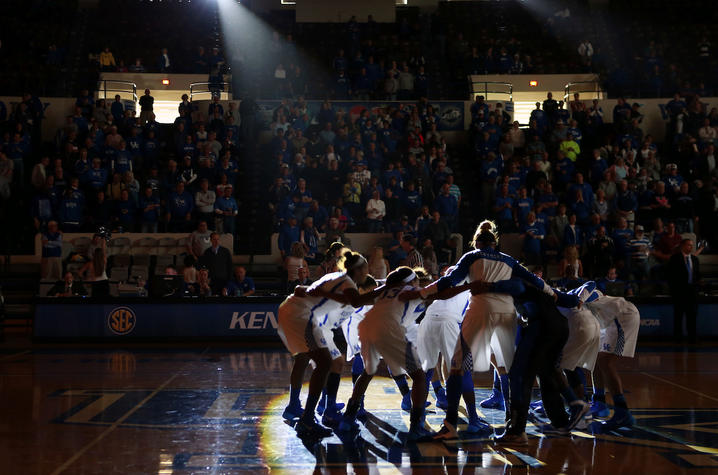How to Train and Recover Like a Pro
LEXINGTON, Ky. (March 21, 2019) — March is upon us. As basketball enthusiasts fill out their brackets in hopes of their favorite team taking home the title, the researchers at the UK Sports Medicine Research Institute (SMRI) are concerned with another aspect of the game — preventing injuries.
According to the British Journal of Sports Medicine, in 2018 over 1,600 injuries were reported in women's college basketball. For men, the total was over 2,300. While these numbers are staggering, it's important to keep in mind that they don't account for the millions of youth and adolescent players across the country.
The most common basketball-related injuries occurring across all age groups include:
- Achilles tendonitis
- Anterior cruciate ligament (ACL) tears
- Ankle sprains
- Finger injuries
- Foot injuries
- Knee tendonitis
- Muscle strains
- Osgood-Schlatter disease
Basketball is a repetitive sport that also includes physical contact, rapid starting and stopping, planting, cutting, and (inevitably) stepping on the feet and ankles of the opposing team. All of these events contribute to the common injuries seen during basketball season.
While many of these injuries are preventable, if they do occur, it's critical to seek proper treatment and rehabilitation for a quick and healthy return to play. Additionally, performance training is essential for optimizing fitness and winning records.
Prevention
Injury prevention strategies should be incorporated into training to lower the risk of injury, but they don’t need to be overwhelming. Many times they can be incorporated in warmups, practice and training. When done correctly, these activities and strategies can stave off injury and even improve in-game performance.
- Agility – the ability to move efficiently during a task.
- Do not do too much too fast – start small and increase gradually.
- Dynamic warm-up – prepare for training and prime the neuromuscular system.
- Multi-sport (youth) – all-around training will make you a better athlete.
- Plyometrics – explosive training to improve jumping ability and speed.
- Strength – improvements in the off season and maintenance in season.
- Rest and recovery – no matter how much you want to practice and play, your body (physically and mentally) will need a break; it’s actually what allows us to get better.
Treatment and Rehabilitation
In the event that injury does occur, basketball players should work with their athletic trainers and healthcare providers to address injury as soon as possible. Learn to recognize how your body feels and when you need to be evaluated for an injury.
Rehabilitation is critical to a successful return to sports following injury. Unfortunately, many people do not complete their prescribed rehabilitation. Athletes must be diligent and disciplined when it comes to working hard and doing their rehab whether at home, in the clinic or in the training room. No one can do this for you. Failure to complete rehabilitation is one of the primary reasons why athletes never fully heal and return to their pre-injury level of play.
No matter how quickly you may want to return to the court, slow and steady wins the game. After sustaining a more serious injury, it is critical focus on regaining your basic foundations before getting back on the court and doing high-demand drills — walk before you can run and run before you can pivot.
Staying active is also essential. Even though athletes may not be able to train or play basketball to full capacity, staying active will help to maintain some level of fitness and control calorie intake. It may take some creativity, but it is all too common for injured athletes to fall into a routine of sitting on couch, playing video games or watching TV, and consuming excessive and poorly balanced nutrition. This, in turn, makes the return from injury and to the basketball court more difficult.
It can be difficult for injured players to sit on the sidelines and watch their teammates, but it's important to keep in mind how critical a proper recovery is in order to contribute to the team in the future.
Performance
Although wins and losses are decided on the court, off-season training is what makes those wins possible. Not only does it contribute to injury prevention once the season starts, it helps hone skills that can carry an athlete throughout the season.
Below is a brief list of off-season activities to help optimize your basketball performance:
- Aerobic: Basketball games are 24-40 minutes long depending on your age, aerobic conditioning will prevent fatigue and keep you working harder longer.
- Agility: Work on speeding up those basketball-specific movements - cones, lines, etc.
- Nutrition: Feed your body to play. This is often underestimated by players of all ages – your output is only as good as what you put into your body.
- Plyometrics: Basketball is a post of vertical inches. This training will help improve your jumps, but also helps improve how you land.
- Rest and recovery: No matter how much you want to practice and play, your body (physically and mentally) will need a break.
- Train the brain: Basketball is as much about decision making as it is about dribbling, shooting, passing, rebounding and playing defense. React fast and make good decisions.





